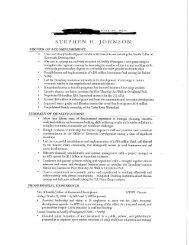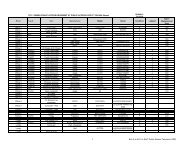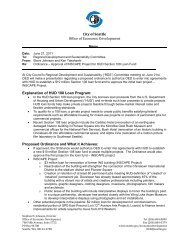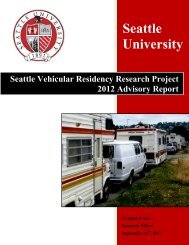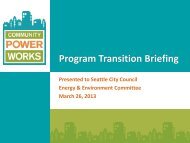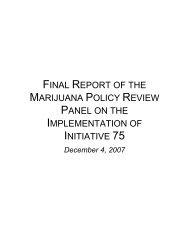2013 Water System Plan, Volume II - Seattle City Clerk's Office - City ...
2013 Water System Plan, Volume II - Seattle City Clerk's Office - City ...
2013 Water System Plan, Volume II - Seattle City Clerk's Office - City ...
You also want an ePaper? Increase the reach of your titles
YUMPU automatically turns print PDFs into web optimized ePapers that Google loves.
Annual Growth in Average <strong>Water</strong> Rates<br />
<strong>Seattle</strong><br />
Retail*<br />
Wholesale<br />
Customers<br />
2010-2015 5.1% 2.0%<br />
2016-2060 0.4% 0.4%<br />
2030-2060 0.4% 0.4%<br />
* Reflects anticipated increases in water and sewer rates<br />
These are less than the average historical rate of growth of about 2.7% since 1974 but are<br />
consistent with the financial forecast used elsewhere in this <strong>Plan</strong>.<br />
Sources: Historical rate and consumption data, SPU 20-year rate models for water and<br />
wastewater, King County Financial <strong>Plan</strong> dated June 27, 2011.<br />
<br />
Conservation - Reductions in <strong>Water</strong> Use due to Passive Savings: Some conservation<br />
savings occur each year without SPU intervention due to federal and state plumbing codes<br />
setting efficiency standards for showerheads, toilets, aerators, and clothes washers. As old<br />
fixtures and appliances are replaced with new ones in existing buildings and new fixtures<br />
and appliances are installed in new construction, water use efficiency improves and<br />
conservation savings accrue. In addition, fixtures and appliances available from the market<br />
at competitive prices often become increasingly more efficient than is required by codes,<br />
especially as more years have passed since the codes were updated. “Passive savings” is<br />
made up of this phenomenon – referred to as “market transformation” – together with “code<br />
savings.” A new model was developed to estimate these savings through 2060.<br />
The model takes account of federal fixture and appliance codes adopted in 1992, 2002 and<br />
2007. In addition, the impact of new clothes washer codes scheduled for adoption in 2011 4<br />
to become effective in 2015 are also included. The model also reflects the current<br />
proportion of fixtures and appliances sold in the market that meet the more stringent<br />
Energy Star, <strong>Water</strong> Sense, and Consortium for Energy Efficiency (CEE) standards, as well<br />
as how those proportions are expected to continue shifting in the direction of higher<br />
efficiency over time. The model assumes that aerators, showerheads, clothes washers and<br />
toilets are, on average, replaced every 5, 10, 12 and 30 years, respectively.<br />
Passive Savings in MGD<br />
Single Multi- Non-<br />
Family family Residential Total<br />
2020 2.5 1.7 0.6 4.9<br />
2030 5.6 4.0 1.2 10.8<br />
2040 7.5 5.8 1.7 15.0<br />
2050 8.5 7.0 2.1 17.7<br />
2060 9.0 7.8 2.4 19.2<br />
Sources: Conservation Potential Assessment (CPA) model, U.S. EPA <strong>Office</strong> of <strong>Water</strong>,<br />
Alliance for <strong>Water</strong> Efficiency, Al Dietemann (personal communication)<br />
4 The US Department of Energy has proposed a two phase clothes washer efficiency standard with the first phase<br />
effective March 7, 2015, and the second, more stringent phase, effective for Janunary 1, 2018. This federal<br />
proposal has yet to be adopted as a final rule.<br />
FINAL Page 7 of 22 Dec 2011, revised June 2012



